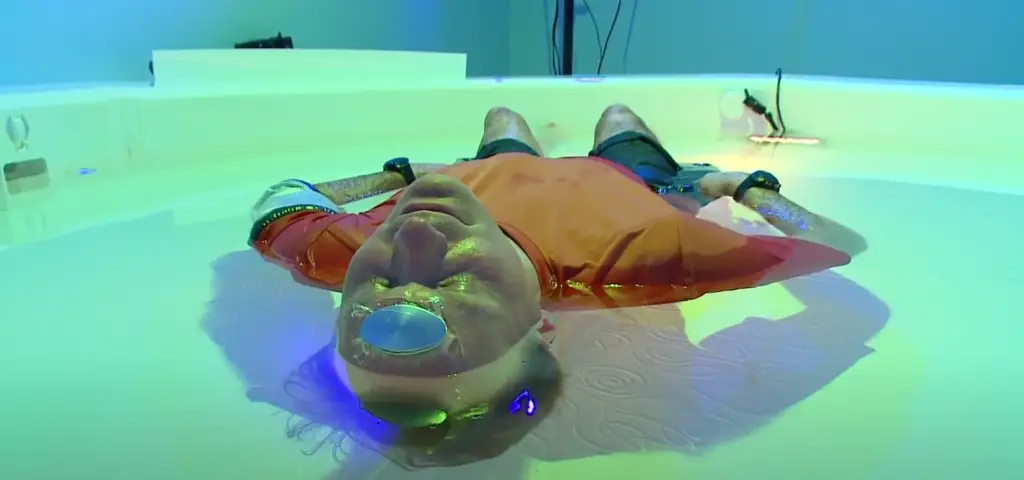Meditation allows the mind to heal along with the body.
But what about those of us who don’t want to practice traditional meditation procedures and learn specific breathing techniques?
Should we be denied the deeper relaxation that meditative experience brings?
Well, that is where floating meditation comes in. Float therapy is a form of deep relaxation that creates a sensory deprivation state for the users to that they can delve into a deep meditation with the help of zero gravity.
So, if you are interested in trying this form of meditation, then this guide will be your one-stop solution for all your inquiries about such meditation.
From the benefits to quick tips, we’ll go through all the details!
What Is Float Tank Therapy?

Flotation therapy is a form of exercise that is conducted in an isolation tank filled with Epsom saltwater with the preferred body temperature of the user.
Using these tanks allows the users to relax their bodies and reach a meditative state without self-regulation.
In simple terms, float therapy meditation is a form of reflective practice through the use of a flotation tank to relax the body and mind.
Delving into Epsom salt-filled water ensures that the user is removed from all types of external stimuli and outside distractions so that they can focus on their mind and emotions.
What are the Different Elements of Float Therapy?

Float tank therapy utilizes the idea of REST therapy. Restricted Environment Stimulation Therapy or REST in short, revolves around the idea of theta waves which ensures that your brain calms down when you fall asleep or experience lucid dreaming.
To create this sensation, float meditation relies on the following elements:
Saltwater
To achieve the floating state, the tanks are filled with Epsom saltwater. This liquid allows the users to float and plays the main part in ensuring sensory deprivation.
Then, the saltwater is adjusted with the body temperature of the user. The primary goal here is to create a soothing atmosphere while you float so that all five senses are less vigilant and there is no tension or stress on the body.
That is why, for relaxation, there are multiple features that a user can utilize with their float tanks.
Ambiance
Generally, this kind of therapy or meditation is conducted in isolation.
So, float tanks have doors that are closed while you float. But if you are uncomfortable in a closed space, you will have the option to keep the door open.
You can also play soft music when you are starting your float therapy. But in most cases, it is recommended that you go with a closed door and complete sound isolation.
This way, there are no distractions for you as you float into a completely peaceful and isolated feeling.
Keep in mind that as soon as the water begins to surround your body, you will start to float as if you are in space and experiencing zero gravity.
It can be a bit unsettling, but the body quickly adapts to the feeling, and you will start to release the tension from your daily lives.
What You Need to Do During Float Meditation
Now if you are new to floating therapies and want to know what you should be doing to achieve floating meditation, then follow these steps.
Start With Mental De-stress
The first thing that you need to do before beginning your float therapy is to de-stress. Your body will start to calm down eventually, but you will have the mental clarity to let your physical self drift in the water.
Do keep in mind that one needs to do a lot of practice to achieve mental de-stress easily. It takes time, so don’t worry if you are not able to completely de-stress yourself.
Say No to Technology
One of the main goals of this meditation experience is to disconnect from the outside world. So, it is essential that you get rid of day-to-day technologies like smartphones, watches, or tablets.
So, get rid of any modern technologies before you start your float therapy.
Remember, float meditation is about spending time with yourself and de-stressing your body and brain, nothing else.
Take a Shower Beforehand
Now, this is a common procedure, but if it hasn’t been pointed out by the authorities, you should take a shower before and after going into a flotation tank.
This will ensure further relaxation for your body which is always beneficial to achieve a perfect meditating state.
Focus on Deep Breathing Practices
Once you have entered the floating chamber or tank and your body starts to float slowly, it is the perfect moment to work on your breathing.
Take slow and deep breaths. This will calm your body, which will help you to relax and release all the negative emotions and physical pressure your body goes through every day.
There is a lot of different type of breathing practices that you can incorporate during the time spent within the chamber.
Don’t worry if you don’t know any breath meditation techniques. Taking a single deep breath can help you reach mindfulness.
Just be focused and control your own breathing, and you will do great.
Try to Focus on Your Body
Now that your inhaling and exhaling are toned down, you need to focus on the well-being of your body and mind, disconnecting from the outside world.
As Epsom saltwater will trigger sensory deprivation, all you need to do is focus on relaxing, and your body will let go of the stress and pain slowly.
Remember, you need to control your respiration during the entire time.
Calm Your Mind Down
Once you are relaxed and have slow but steady breathing, you need to move into calming your mind. There are two states that the mind goes to during floating meditation: Active State and Passive State.
When you are in the Active State, your brain will be thoughtful, so it is better to reflect upon your actions and plan for the future. Maybe you can set up some new goals in this state.
On the other hand, in the Passive State, your body and mind reach complete mindfulness, so you should just let go of any lingering stress or negative thoughts and feelings from the external world.
You can also let your creativity flow through yourself in the passive floating state.
Visualize and Let Go of the Present Moment
Sometimes we are too aware and can’t reach the passive floating state. For this, we need to let go of the present moment by visualizing scenarios that make our minds come and compose.
Visualization is a crucial part of meditation, so don’t be afraid to dive deep into your mind’s pictures as you start floating on the water.
The Benefits of Floating Meditation
Well, now that we got an idea of what floating meditation is and how it is achieved.
Let’s take a look at some of the benefits of float tank meditation
- Reduces Negative Feelings and Stress
Studies have shown that when your body starts to drift in the water, it decreases cortisol which is a stress hormone.
Due to this, we start to have fewer negative thoughts during floating therapy which allows us to gain mindfulness. This also helps on reducing the chance of getting stress-related sicknesses.
- Releases Positive Neurotransmitters
When we are floating and our physical self is relaxed, dopamine is released. This hormone is associated with making us feel happy and well.
Along with dopamine, other endorphins are also released. This allows us to feel more jolly after a floating session.
- Ensures Self Reflection
Last but not least, doing floating meditation for long periods allow us to self-reflect on our actions.
We are also able to think more clearly due to our body being relaxed and our mind being in a clear state.
How Effective Is Float Tank Meditation Practice?
The benefits do sound quite helpful, but are they actually effective?
Yes, doing floating meditation regularly has shown to be quite effective. For most people, the signs of improvement show right after the first session.
People with chronic back pain seems to get the best results just after their first try. Regular usage of float meditation has shown to take care of years of unresolved body stress and pain.
The effectiveness of float tank meditation can also be observed from skeptical customers. Many float meditation centers face customers who think they won’t be able to meditate more than 10 minutes in isolation.
But almost everyone end up using their total hours even without noticing how much time has passed. Even practitioners from other forms of meditations adored their first float tank meditation, here is one you can check out!.
Give it a try, and we can assure you that you won’t regret your decision!
Can Float Tank Meditation Replace Traditional Meditation?
Float tank meditation is a great technique for people to meditate. However, it is still not competent enough to challenge traditional meditation that people can achieve through yoga.
Observation and knowledge on other forms of traditional meditation can help in this regard. We recommend you check other guides and articles confronting different types of meditation.
But floating meditation and traditional meditation shouldn’t clash with each other. Instead, utilizing them together has shown to be the most effective.
So, if you know a bit about yoga, it will surely help you to be more composed when you are going through floating therapy.
However, it is not necessary to learn yoga to utilize float therapy.
Final Thoughts
Floating meditation can be a great option to relax both the mind and the body. The cost is also relatively low, and you can see the results right after the first session.
So, we highly recommend that you give float therapies a shot and enjoy a deeper and highly relaxed meditation experience.
